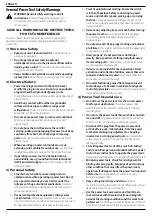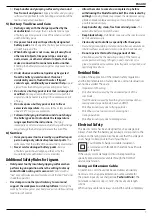
7
EngliSh
h )
Keep handles and grasping surfaces dry, clean and
free from oil and grease.
Slippery handles and grasping
surfaces do not allow for safe handling and control of the
tool in unexpected situations.
5) Battery Tool Use and Care
a )
Recharge only with the charger specified by the
manufacturer.
A charger that is suitable for one type
of battery pack may create a risk of fire when used with
another battery pack.
b )
Use power tools only with specifically designated
battery packs.
Use of any other battery packs may create
a risk of injury and fire.
c )
When battery pack is not in use, keep it away from
other metal objects, like paper clips, coins, keys,
nails, screws, or other small metal objects, that can
make a connection from one terminal to another.
Shorting the battery terminals together may cause burns
or a fire.
d )
Under abusive conditions, liquid may be ejected
from the battery; avoid contact. If contact
accidentally occurs, flush with water. If liquid
contacts eyes, additionally seek medical help.
Liquid
ejected from the battery may cause irritation or burns.
e )
Do not use a battery pack or tool that is damaged or
modified.
Damaged or modified batteries may exhibit
unpredictable behavior resulting in fire, explosion or risk
of injury.
f )
Do not expose a battery pack or tool to fire or
excessive temperature.
Exposure to fire or temperature
above 130 °C may cause explosion.
g )
Follow all charging instructions and do not charge
the battery pack or tool outside the temperature
range specified in the instructions.
Charging
improperly or at temperatures outside the specified range
may damage the battery and increase the risk of fire.
6) Service
a )
Have your power tool serviced by a qualified repair
person using only identical replacement parts.
This
will ensure that the safety of the power tool is maintained.
b )
Never service damaged battery packs.
Service
of battery packs should only be performed by the
manufacturer or authorized service providers.
Additional Safety Rules for Jigsaws
•
Hold power tool by insulated gripping surfaces when
performing an operation where the cutting tool may
contact hidden wiring or its own cord.
Contact with a
“live” wire will make exposed metal parts of the tool “live” and
shock the operator.
•
Use clamps or another practical way to secure and
support the workpiece to a stable platform
. Holding the
work by hand or against your body leaves it unstable and may
lead to loss of control.
•
Allow the motor to come to a complete stop before
withdrawing the blade from the kerf (the slot created by
cutting).
A moving blade may impact the workpiece causing
a broken blade, workpiece damage or loss of control and
possible personal injury.
•
Keep handles dry, clean, free from oil and grease.
This
will enable better control of the tool.
•
Keep blades sharp.
Dull blades may cause the saw to swerve
or stall under pressure.
•
Clean out your tool often, especially after heavy use.
Dust and grit containing metal particles often accumulate on
interior surfaces and could create an electric shock hazard.
•
Do not operate this tool for long periods of time.
Vibration caused by the operating action of this tool may
cause permanent injury to fingers, hands, and arms. Use
gloves to provide extra cushion, take frequent rest periods, and
limit daily time of use.
Residual Risks
In spite of the application of the relevant safety regulations
and the implementation of safety devices, certain residual risks
cannot be avoided. These are:
• Impairment of hearing.
• Risk of accidents caused by the uncovered parts of the
saw blade.
• Health hazards caused by breathing dust developed when
sawing wood, especially oak, beech and MDF.
• Risk of personal injury due to flying particles.
• Risk of burns due to accessories becoming hot
during operation.
• Risk of personal injury due to prolonged use.
Electrical Safety
The electric motor has been designed for one voltage only.
Always check that the battery pack voltage corresponds to the
voltage on the rating plate. Also make sure that the voltage of
your charger corresponds to that of your mains.
Your
D
e
WALT
charger is double insulated in
accordance with IEC60335; therefore no earth wire
is required.
If the supply cord is damaged, it must be replaced by a
specially prepared cord available through the
D
e
WALT
service organisation.
Using an Extension Cable
An extension cord should not be used unless absolutely
necessary. Use an approved extension cable suitable for
the power input of your charger (see
Technical Data
). The
minimum conductor size is 1 mm
2
; the maximum length
is 30 m.
When using a cable reel, always unwind the cable completely.
Содержание XR DCS334
Страница 1: ...DCS334 DCS335 ...
Страница 2: ...B Copyright DeWALT English 5 한국어 16 ...
Страница 3: ...1 Fig A 그림 A DCS334 4 5 6 8 7 1 2 3 9 DCS335 5 6 7 1 9 3 8 10 4 10 ...
Страница 4: ...2 Fig B 그림 B Fig C 그림 C Fig D 그림 D Fig E 그림 E 12 12 11 11 14 13 4 8 7 ...
Страница 5: ...3 Fig F 그림 F Fig H 그림 H Fig I 그림 I Fig J 그림 J Fig K 그림 K 6 Fig G 그림 G 19 15 16 7 17 18 20 1 3 2 3 ...
Страница 6: ...4 Fig L 그림 L Fig M 그림 M 9 DCS334 DCS335 9 Fig N 그림 N ...
Страница 28: ...N696976 05 2019 ...










































